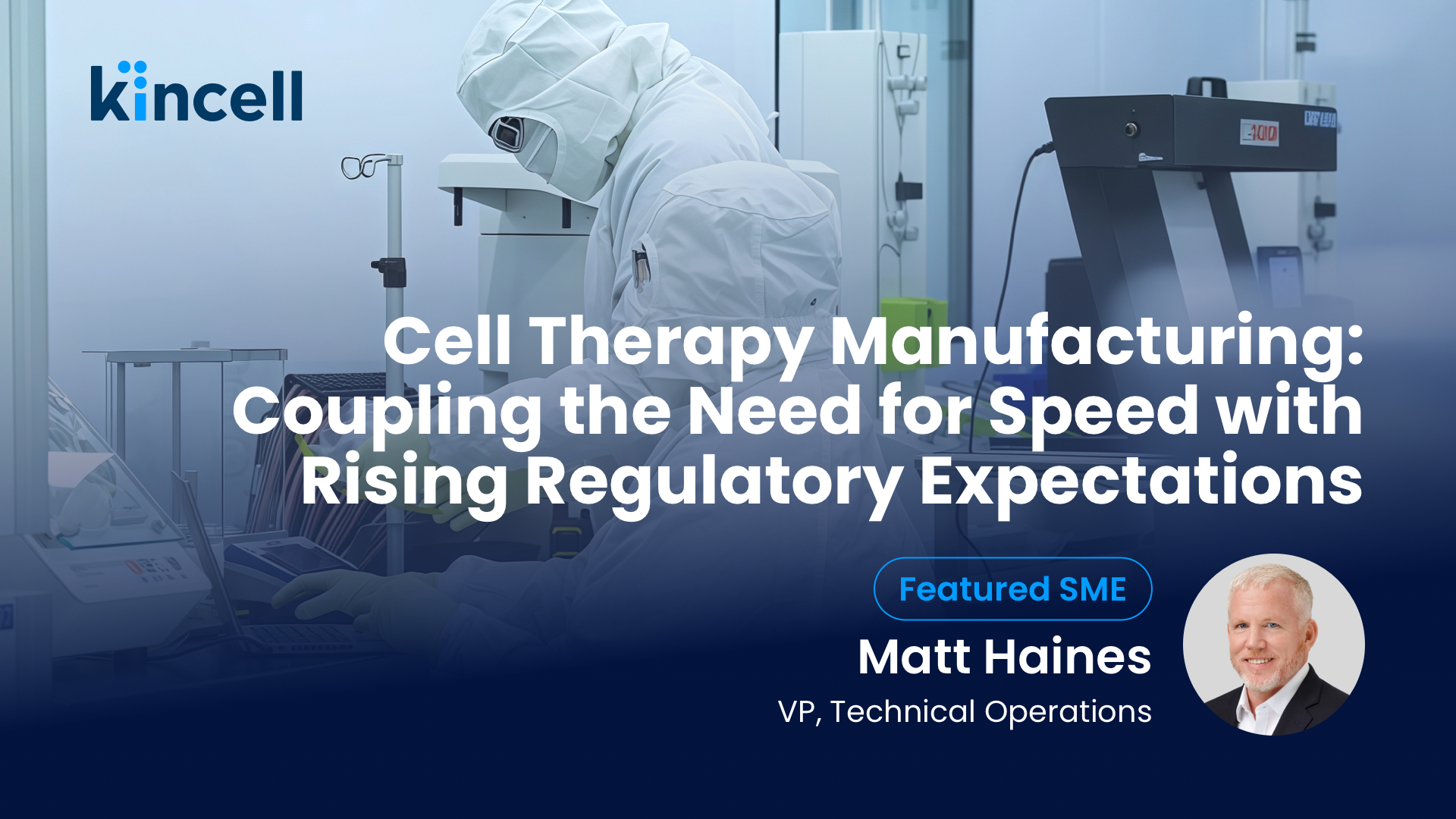News & Insights

Today’s cell therapy manufacturing processes are resource- and labor-intensive and facing challenges such as batch variability, supply chain issues, and immature regulatory frameworks. However, as more cell therapies progress through the development pipeline to the market, regulators’ expectations are rising, resulting in a need for cell therapy developers to seek manufacturing expertise that meets the evolving demands.
Among the many challenges in cell therapy development and manufacturing is that many programs must move rapidly, often progressing from a promising signal to pivotal studies within a handful of years. While speed is essential for patients and for innovators to capitalize on market opportunity, it tends to expose weaknesses in manufacturing strategy, platform choices, and supply chain planning. In a recent conversation with Matt Haines, VP of Technical Operations at Kincell Bio, we discussed some of the issues on his mind and those of the industry in the pursuit of successfully delivering more cell therapies to the market.
Consider Commercial Needs Early
While often repeated as an industry cliché, starting with the end in mind is truly necessary to avoid extremely costly rework, or even a Complete Response Letter (CRL), which will delay market entry and revenue generation, and possibly erode investor confidence. However, Kincell Bio understands the near-term milestone pressures well; therefore, it firmly believes in executing near-term work within a long-term, commercial framework.
“We have to be successful in the short term because time is of the essence for most funded cell therapy developers,” Haines commented. “We need to make sure we’re achieving their shorter-term milestone goals within a longer-term vision. So, we keep a product’s full lifecycle in mind, chart a recommended path to commercial manufacturability, while understanding that we need to be nimble.”
While compromises typically need to be made to balance the early-phase speed with later-phase rigor, Kincell is a strong advocate of strategically thinking through the decisions being made, recognizing the necessary sacrifices in speed or robustness. The decisions made for a specific program will vary depending on multiple consideration factors; it is critical to make decisions thoughtfully with a full understanding of the inevitable downsides.
The Contrasting Needs of Autologous & Allogeneic Manufacturing Approaches
As if advancing cell therapy manufacturing processes is not tricky enough, the cell therapy industry is pursuing two distinct manufacturing strategies. Programs for autologous cell therapies utilize a patient’s own cells; therefore, they require the production of many individual batches. The approach is one of scaling out, rather than scaling up. Because you perform the same operation many times, one batch for each patient, moving toward repeatable and reliable processes that will eventually become highly automated, is paramount. Because it involves one batch per patient, the only sustainable path to reducing costs and improving access is to minimize human touchpoints and errors, streamline steps, standardize operations, and automate wherever possible.
Conversely, allogeneic programs utilize a classic scale-up construct, so developing equipment platforms and processing strategies that increase yield and the number of patients served per batch is critical. Ultimately, automation will also matter for allogeneic programs, but commercial viability hinges first on platform selection and scale-up performance.
Question the Impulse to Go as Fast as Possible
Early clinical signals create a powerful urge to sprint to the clinic. When a program shows promise for a hard-to-treat population, teams often push forward with a functional process in their drive to the clinic, deferring platform, scalability, and automation choices.
These compromises can quickly move you into Phase 2, pivotal studies, and even commercialization, but they also introduce variability, increase the cost of goods, and create processing inefficiencies. In these cases, a follow-on project will likely be necessary to rebuild what should have been designed from the start. Sometimes the decision to advance as rapidly as possible, despite the need for costly process redesign, is the only logical avenue given funding constraints and the need to be first-to-market. However, it’s prudent to consider the question of the return on robust early-phase process development investment.
Cell Therapy Manufacturing Platforms Must Standardize
“A recurring pain point when programs arrive at Kincell is that too many bespoke equipment choices have been made under research-phase pressures,” explained Haines. “In early development, teams often pick what ‘works now,’ not what will scale, be supported globally, or meet cost of goods and GMP expectations.”
For cell therapies to have their deserved role in the medical community’s therapeutic toolbox, processing platforms will need to standardize to a much greater degree than they are today. Kincell is continually collaborating with a cross-section of the cell therapy industry to advance these platform standardization efforts. Haines further commented, “The needed enabling technologies will reach a point of much greater maturity within the upcoming years. We are just not quite there yet.”
More Stringent Regulatory Expectations
Emerging therapies, particularly those with the potential to be lifesaving for unmet medical needs, tend to be given a fair amount of regulatory latitude in the early stages. As regulators and industry alike learn more through multiple approval processes, the regulatory bar rises.
“What was acceptable two or three years ago is not acceptable now,” mentioned Haines. “Sponsors still need to move quickly as they are typically filing leveraging one of FDA’s expedited constructs, but regulators’ increased expectations require manufacturing teams to support the development team in earlier and earlier phases.”
Kincell’s response is both cultural and procedural. The company prides itself on being audit-ready every day. “How we operate day to day is not any different than how we would operate during an audit,” Haines explained. Rather than a top-down paper exercise or an outsourced readiness project, Kincell develops approaches by engaging the people who run the processes. First-hand familiarity, combined with the leadership team’s extensive experience, makes identifying gaps and areas for optimization highly effective.
Kincell Bio Helps Innovators Balance Urgency with Commercial Viability
Cell therapy development will always demand urgency, but speed without a scalable, inspection-ready foundation is no longer viable. The path forward is to pair rapid clinical progress with increasingly disciplined and standardized platform choices, further automation, and a focus on successful commercialization from day one.
That’s the operating model at Kincell Bio: standardize where it counts, automate to remove human variability wherever possible, design for comparability and supply resilience, and run every suite as if an inspector will arrive tomorrow. With this balance of pace and rigor, developers can avoid costly resets, meet rising regulatory expectations, and deliver more consistent, accessible therapies to patients. Let’s discuss how Kincell Bio can help support your program.
Featured SME

Matt Haines
VP, Technical Operations
Matt Haines is the VP, Technical Operations at Kincell Bio, where he leads the buildout and operation of Kincell’s manufacturing capabilities.
Before joining Kincell, he served as Vice President, Manufacturing Operations, at Inceptor Bio, and as Senior Director of Manufacturing at AveXis/Novartis Gene Therapies, where he played a key role in the successful approval and launch of a commercial gene therapy, as well as in expanding their manufacturing network. In his 20+ years in the biotech industry, he has held various roles within manufacturing, engineering, manufacturing sciences, and quality at companies such as Biogen, Amgen, and Merck. Matt earned his BS in Chemical Engineering from Drexel University.
